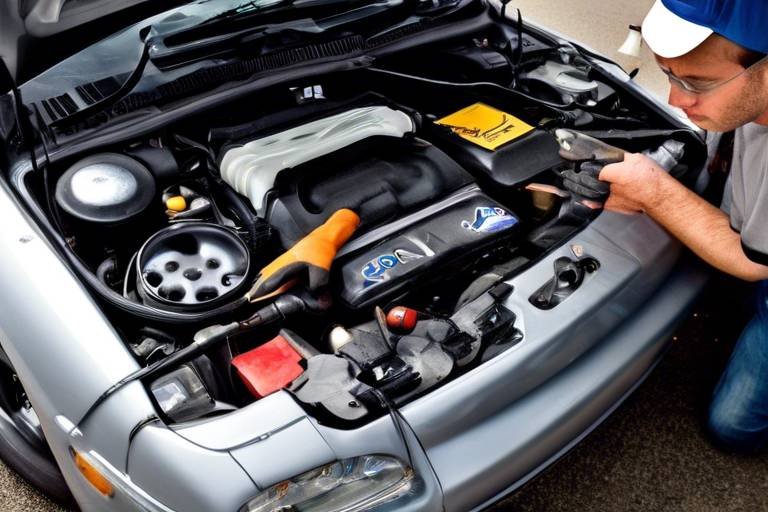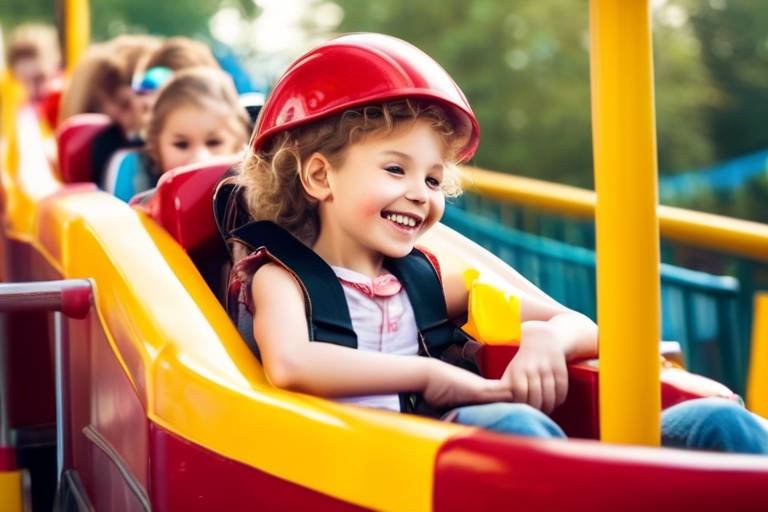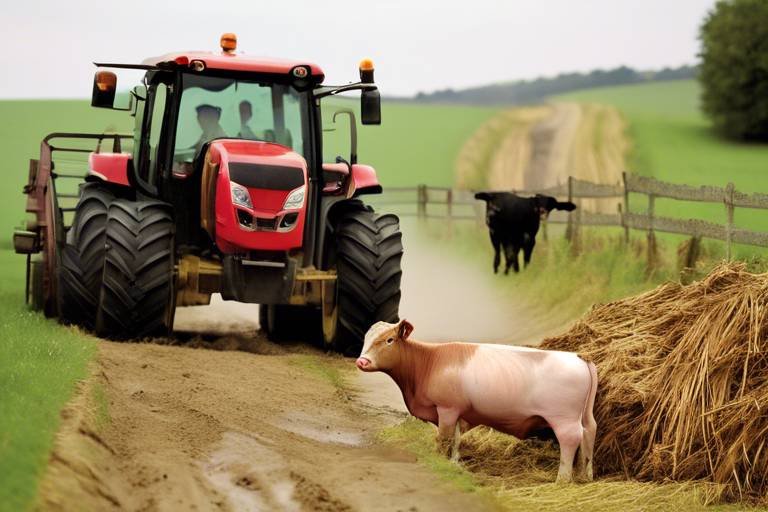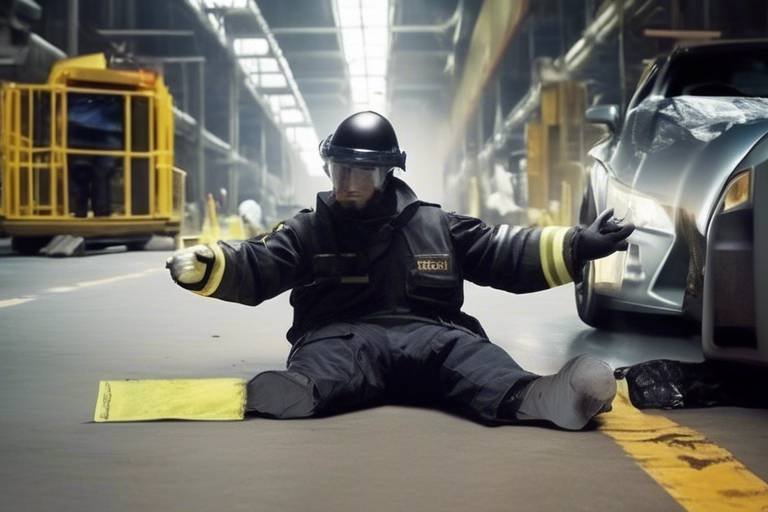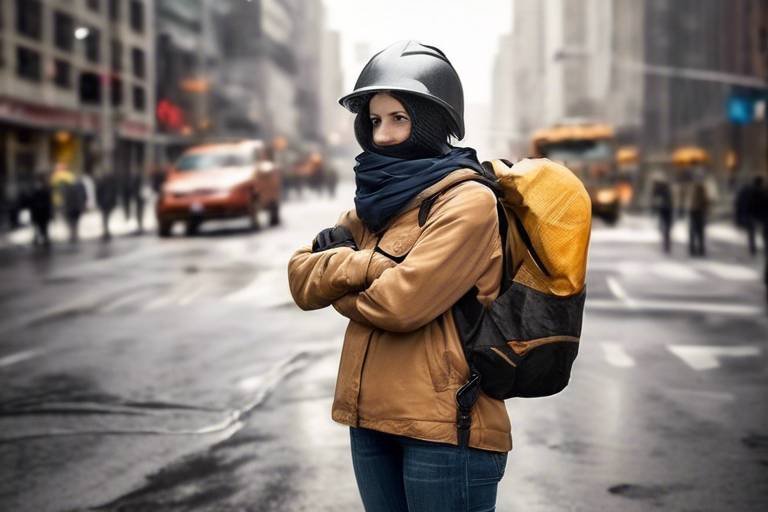Ensuring Your Safety While Using a Chainsaw
Using a chainsaw can be an incredibly rewarding experience, whether you're clearing fallen branches, cutting firewood, or tackling larger landscaping projects. However, with great power comes great responsibility, and it's crucial to prioritize safety every step of the way. This article covers essential safety measures, techniques, and equipment to protect yourself while operating a chainsaw, ensuring a safe and efficient experience for both beginners and experienced users.
Proper safety gear is vital when using a chainsaw. Think of it as your protective armor in a world full of potential hazards. Wearing the right equipment can significantly reduce the risk of injury, making your chainsaw experience much safer. Essential safety gear includes:
- Helmets: Protects your head from falling debris.
- Face Shields: Shields your face and eyes from flying particles.
- Gloves: Provides grip and protects your hands from cuts and abrasions.
- Chaps: Offers protection to your legs against accidental cuts.
- Steel-Toed Boots: Safeguards your feet from heavy falling objects.
Investing in high-quality safety gear is a small price to pay for the peace of mind it brings. Remember, when you're out there wielding a powerful tool, it's not just about your skills; it's about being prepared for anything that comes your way.
Before starting your chainsaw, conducting safety checks is crucial. Think of this as a ritual that sets the stage for a safe operation. A few minutes of inspection can save you from potential accidents. Here’s what you should look for:
Learn how to examine critical parts of the chainsaw to guarantee they are functioning correctly and safely before use. Key components to check include:
- The Chain: Ensure it's sharp and properly tensioned.
- The Bar: Look for any signs of wear or damage.
- The Throttle: Test the throttle response to ensure it operates smoothly.
By conducting these checks, you're not just ensuring your chainsaw is ready to go; you're also taking proactive steps to prevent accidents.
Maintaining appropriate fuel and oil levels is essential for optimal performance. A chainsaw that runs out of fuel or oil mid-operation can lead to dangerous situations. Always check and refill these fluids safely before you start. Make it a habit to keep a fuel can and oil handy, so you're never caught off guard.
Modern chainsaws come with various safety features that can be lifesavers. Understanding and utilizing these built-in protections is critical. Look for features such as:
- Chain Brake: Stops the chain immediately in case of kickback.
- Throttle Lock: Prevents accidental acceleration.
- Low Kickback Chains: Designed to reduce the risk of kickback.
Familiarizing yourself with these features can make a significant difference in your safety while operating a chainsaw.
A well-prepared work area minimizes hazards. Before you even think about starting your chainsaw, take a moment to assess your surroundings. Ensure the area is clear of obstacles, debris, and other potential hazards. A clean workspace not only enhances safety but also improves efficiency. Consider marking your work zone to keep bystanders at a safe distance.
Using the correct handling techniques is vital for safety. The way you grip and position your body can make all the difference when it comes to maintaining control while operating a chainsaw. Here are some essential tips:
A firm grip on the chainsaw enhances control. Hold the front handle with your left hand and the rear handle with your right. Keep your hands dry and ensure your gloves have a good grip. This simple adjustment can help avoid slips and accidents during operation. Always be aware of your surroundings and stay focused; distractions can lead to serious mistakes.
Correct body positioning is crucial for balance and stability. Stand with your feet shoulder-width apart for a solid base. Lean slightly forward to maintain control and be ready to react to any unexpected movements. Remember, your body is your best tool for stability; use it wisely!
Understanding emergency procedures can save lives. In the unfortunate event of an accident, knowing what to do can make all the difference. Always have a first aid kit on hand, and familiarize yourself with the contact details of emergency services. Here are some key points to consider:
Familiarize yourself with common chainsaw-related injuries. These can include cuts, lacerations, and even more severe injuries. Recognizing the signs early can help you respond more effectively. If you notice excessive bleeding or severe pain, it's essential to seek medical attention immediately.
Learn basic first aid techniques suitable for chainsaw injuries. If you encounter a minor cut, clean the wound with soap and water, apply an antiseptic, and cover it with a bandage. For more severe injuries, apply pressure to stop the bleeding and keep the injured area elevated if possible. Always err on the side of caution; if in doubt, call for help.
Q: What should I do if my chainsaw starts to kick back?
A: Immediately release the throttle and let the chain come to a stop. Maintain a firm grip and reposition your body to regain control.
Q: How often should I check my chainsaw’s safety features?
A: It's best to check safety features before every use, ensuring everything is functioning correctly.
Q: Can I use a chainsaw without safety gear?
A: No, using a chainsaw without proper safety gear significantly increases your risk of injury.
By following these guidelines and prioritizing safety, you can enjoy the benefits of using a chainsaw while minimizing risks. Stay safe and happy cutting!

Understanding Chainsaw Safety Gear
When it comes to using a chainsaw, the very first step towards ensuring your safety is investing in the right safety gear. Think of it as your protective armor—just like a knight wouldn't head into battle without their shield and helmet, you shouldn't operate a chainsaw without the appropriate equipment. This gear is designed to minimize the risk of injury, making your chainsaw experience not only safer but also more efficient.
So, what exactly should you be wearing? Let's break it down. The essential components of chainsaw safety gear include:
- Helmet: A sturdy helmet protects your head from falling branches and debris. Many helmets come equipped with a face shield to guard your face and eyes from flying particles.
- Gloves: High-quality gloves provide a solid grip on the chainsaw, while also protecting your hands from cuts and abrasions. Look for gloves made from durable materials that offer both flexibility and protection.
- Chaps: Chainsaw chaps are made from special materials that can stop a chainsaw chain upon contact. Wearing chaps is crucial, as they cover your legs and can prevent serious injuries.
- Steel-Toed Boots: These boots provide essential foot protection and stability. A good pair of steel-toed boots can protect your feet from heavy logs and sharp tools.
- Ear Protection: Chainsaws are loud machines, and prolonged exposure can lead to hearing damage. Use ear muffs or plugs to protect your ears.
It's important to remember that wearing safety gear isn't just about looking the part; it's about reducing the likelihood of accidents. Even if you're an experienced chainsaw user, accidents can happen in the blink of an eye. The right gear can be the difference between a minor incident and a serious injury.
Moreover, make sure that your safety gear fits properly. Gear that is too loose can get caught in the chainsaw, while gear that is too tight can restrict your movement. Think of it like wearing a seatbelt—if it’s not snug and secure, it won’t do its job effectively.
In addition to personal protective equipment, consider the environment in which you’re operating the chainsaw. For instance, if you’re working in a particularly muddy or uneven area, you might want to invest in additional gear like knee pads for extra protection and comfort. Always assess your surroundings and adapt your safety gear accordingly.
In summary, chainsaw safety gear is not just an accessory; it's an essential part of your operation. By equipping yourself with the right gear, you are taking the first step in creating a safe working environment. So, before you start that chainsaw, make sure you’re fully geared up. Your safety is worth it!

Pre-Operation Safety Checks
Before you unleash the power of your chainsaw, it's absolutely vital to perform some . Think of this step as your warm-up routine before a big game; it sets the tone for a safe and effective operation. Skipping these checks can lead to accidents that could have been easily avoided. So, what exactly should you be looking for? Let’s dive into the essential inspections that will keep you and your surroundings safe.
First and foremost, you need to inspect the chainsaw components. This includes checking the chain, bar, and throttle. The chain should be sharp and free of any damage. A dull or damaged chain can not only make your job harder but can also increase the risk of kickback, which is when the chainsaw unexpectedly jerks back towards you. Ensure the bar is properly aligned and that there are no cracks or bends. Lastly, the throttle should respond smoothly without sticking. If any of these components are off, it’s better to fix them before you start.
When inspecting the chainsaw, pay close attention to the following components:
| Component | What to Check | Signs of Damage |
|---|---|---|
| Chain | Sharpness and tension | Dullness, missing teeth |
| Bar | Alignment and wear | Cracks, bends, excessive wear |
| Throttle | Smooth operation | Sticking or unresponsive |
Next up, checking fuel and oil levels is crucial for optimal performance. You wouldn’t drive a car without checking the gas gauge, right? The same logic applies here. Ensure that your chainsaw has the proper fuel mixture, typically a blend of gasoline and two-stroke oil. If you’re unsure about the correct ratio, consult the manufacturer's guidelines. Additionally, check the oil reservoir to ensure there’s enough chain oil to lubricate the chain during operation. Running a chainsaw without adequate lubrication can lead to severe damage.
Here’s a quick checklist for checking fuel and oil levels:
- Use the right fuel mixture as per the manufacturer's instructions.
- Check for leaks or spills around the fuel cap.
- Ensure the oil reservoir is filled appropriately.
Finally, it’s essential to examine the safety features of your chainsaw. Modern chainsaws come equipped with various safety mechanisms designed to protect you during operation. Familiarize yourself with these features, such as chain brakes, throttle locks, and anti-vibration systems. Understanding how these safety features work can make a world of difference in preventing accidents. Always ensure that these features are functioning correctly before you start cutting.
Here are some common safety features to check:
- Chain Brake: Engages automatically when the saw is dropped or kicked back.
- Throttle Lock: Prevents the throttle from being activated accidentally.
- Anti-Vibration System: Reduces fatigue and increases control.
In conclusion, taking the time to perform these pre-operation safety checks can significantly enhance your safety and efficiency while using a chainsaw. It’s like putting on a seatbelt before driving; it’s a small step that can have a massive impact. Remember, safety first!
Q: How often should I perform these safety checks?
A: It’s best to perform these checks every time you use your chainsaw. Regular maintenance ensures your equipment is always in top shape.
Q: What should I do if I find a damaged part?
A: If you discover any damaged components, it’s crucial to repair or replace them before using the chainsaw. Never compromise on safety!
Q: Are there any specific safety features I should look for in a chainsaw?
A: Yes! Look for features like chain brakes, throttle locks, and anti-vibration systems to enhance your safety while operating the chainsaw.

Inspecting the Chainsaw Components
When it comes to using a chainsaw, ensuring that all components are in top-notch condition is not just a good idea; it’s a necessity. Think of your chainsaw as a finely tuned machine, where every part plays a critical role in its performance and your safety. Before you even think about firing it up, take a moment to inspect the essential parts of your chainsaw to guarantee they are functioning correctly and safely. This proactive approach can save you from unexpected accidents and equipment failures.
The first component to examine is the chain. It should be sharp, properly tensioned, and free from any damage. A dull chain not only makes cutting more difficult but also increases the risk of kickback, which can be dangerous. To check the tension, lift the chain slightly away from the bar; it should snap back into place easily. If it doesn’t, you likely need to adjust it. Additionally, inspect the teeth of the chain for any signs of wear or damage. If you notice any missing or broken teeth, it’s time for a replacement.
Next, turn your attention to the bar. This is the long metal piece that the chain wraps around. Look for any signs of bending, wear, or damage. A warped bar can lead to uneven cuts and may even cause the chain to derail. Ensure that the bar is lubricated properly, as this will help reduce friction and prolong its life. If you notice any significant damage, consider replacing the bar before starting your work.
Don’t forget to check the throttle. This component controls the speed of the chain, and it’s crucial for maintaining control during operation. Make sure it operates smoothly without sticking. If you find that the throttle is unresponsive or erratic, it could be a sign of a malfunction that needs immediate attention. Remember, a well-functioning throttle is key to a safe and efficient cutting experience.
Lastly, consider the safety features that come with modern chainsaws. These can include chain brakes, anti-vibration systems, and kickback guards. Familiarizing yourself with these features is essential. Test the chain brake by pulling the lever to ensure it engages properly. A malfunctioning brake can lead to serious injuries in case of kickback. Understanding how these safety features work can make a significant difference in your overall safety while operating the chainsaw.
In summary, inspecting the components of your chainsaw is a straightforward yet crucial task that can drastically improve your safety and efficiency. By taking the time to check the chain, bar, throttle, and safety features, you set yourself up for a successful and safe cutting experience. Remember, a few minutes spent on inspection can save you hours of trouble later on!
- How often should I inspect my chainsaw components? It's recommended to inspect your chainsaw components before each use to ensure they are in good working condition.
- What should I do if I find a damaged chain? If you notice any damage to the chain, replace it immediately to avoid accidents.
- Can I operate a chainsaw with a dull chain? While you may be able to operate it, a dull chain is unsafe and inefficient. Always sharpen or replace it before use.
- How do I know if my throttle is malfunctioning? If the throttle does not respond smoothly or sticks, it may be malfunctioning and should be checked by a professional.

Checking Fuel and Oil Levels
When it comes to operating a chainsaw safely, one of the most critical steps that should never be overlooked is . Think of your chainsaw as a finely tuned machine; just like a car, it needs the right amount of fuel and oil to run smoothly and efficiently. If you neglect this vital step, you could find yourself in a sticky situation—literally and figuratively!
Before you even think about starting your chainsaw, take a moment to ensure that both the fuel and oil are at appropriate levels. This not only helps in maintaining the performance of the chainsaw but also minimizes the risk of potential accidents caused by equipment failure. Imagine trying to drive a car on empty; it’s not just inconvenient, it can lead to serious issues. The same logic applies here.
To check the fuel level, locate the fuel cap and carefully remove it. Look inside to gauge how much fuel is left. If you can’t see the fuel clearly, use a dipstick or a measuring stick to check the depth of the fuel. Ideally, you want to keep the tank at least half full to avoid running out of fuel mid-operation. Running low on fuel not only interrupts your work but can also cause the engine to overheat, leading to costly repairs.
Next, let’s talk about the oil. Chainsaw oil is crucial for lubrication, ensuring that the chain moves smoothly without excessive friction. To check the oil level, look for the oil reservoir, which is often transparent or has a sight window. If the oil level is low, it’s essential to refill it before you start cutting. Remember, using the right type of oil is equally important; always refer to your chainsaw’s manual for recommendations.
| Fluid Type | Recommended Level | Notes |
|---|---|---|
| Fuel | At least 50% full | Use fresh fuel; old fuel can cause engine issues. |
| Oil | Full | Check for proper lubrication; use the manufacturer’s recommended oil. |
In summary, regularly checking your fuel and oil levels is not just a good practice; it's a crucial safety measure that can prevent accidents and ensure your chainsaw operates at its best. So, before you rev up that engine, take a moment to perform this essential check. Your safety and the longevity of your chainsaw depend on it!
- How often should I check the fuel and oil levels? It's best to check them before each use to ensure optimal performance.
- What type of oil should I use for my chainsaw? Always refer to the manufacturer's manual for the recommended oil type.
- Can I use old fuel in my chainsaw? It's not advisable. Old fuel can cause starting issues and damage your engine.

Examining Safety Features
When it comes to chainsaws, understanding the safety features built into your equipment can be a game changer. These features are designed to protect you while you work, making your experience not only safer but also more efficient. Think of them as the seatbelts and airbags of the chainsaw world—essential for your safety. So, what are these features, and how do they work? Let's dive in!
First off, many modern chainsaws are equipped with a chain brake. This nifty feature is designed to stop the chain almost instantly if the saw kicks back, which is one of the most dangerous situations a user can face. Kickback occurs when the tip of the chainsaw bar strikes an object or when the chain gets pinched, causing the saw to jerk back towards the operator. The chain brake can be activated manually by pushing the front hand guard forward or automatically during a kickback incident. It's like having a safety net that catches you when you stumble!
Another important safety feature is the anti-vibration system. Chainsaws can generate a lot of vibrations during operation, which can lead to discomfort or even long-term injuries like Hand-Arm Vibration Syndrome (HAVS). An anti-vibration system helps to dampen these vibrations, making it easier to handle the saw for extended periods without feeling fatigued. Imagine trying to hold a jackhammer for hours—your hands would be numb! The anti-vibration feature allows you to focus on the task at hand without the added stress on your body.
Additionally, many chainsaws come with a low kickback chain. This type of chain is specifically designed to reduce the chances of kickback occurring, which is a significant safety concern. It has a special design that minimizes the risk of the tip of the bar making contact with objects, thus decreasing the likelihood of a dangerous kickback. If you’re serious about safety, opting for a chainsaw with a low kickback chain is a wise choice.
Lastly, don’t overlook the importance of safety labels and user manuals. These resources provide critical information about the specific safety features your chainsaw possesses and how to use them effectively. Make it a habit to read through the manual before starting your chainsaw; it’s like reading the instructions before assembling a piece of furniture. You wouldn’t want to end up with a wobbly chair, right?
In summary, examining the safety features of your chainsaw is not just a good practice; it's essential for ensuring your safety and the safety of those around you. Always take the time to familiarize yourself with these features, and don’t hesitate to reach out to the manufacturer if you have questions. Remember, a well-informed operator is a safe operator!

Preparing the Work Area
Before you even think about starting that chainsaw, it's absolutely essential to prepare your work area. Picture this: you're ready to tackle a big project, the sun is shining, and you've got your trusty chainsaw by your side. But wait! Have you looked around? A cluttered or hazardous workspace can turn your productive day into a trip to the emergency room in the blink of an eye. So, let’s dive into how to create a safe and efficient environment for chainsaw operation.
First things first, clear the area of any debris, tools, or obstacles. This means removing branches, leaves, rocks, or anything else that could trip you up. You want a clear zone of at least 10 feet around your work area. This space allows you to move freely and safely while operating the chainsaw. It’s like setting up your own personal safety bubble!
Next, consider the ground surface. Is it stable? If you’re working on uneven or slippery terrain, you might want to lay down some plywood or mats to create a more secure footing. Remember, a solid stance is key to maintaining control of your chainsaw. Think of it as laying the foundation for a house; without a solid base, everything else can come crumbling down.
Also, take a moment to assess your surroundings. Are there any overhead hazards, like low branches or power lines? If so, it’s best to avoid cutting in those areas or make arrangements to mitigate those risks. Always be aware of the direction in which the tree or limb will fall. It’s crucial to have a clear escape route, just in case things don’t go as planned.
Finally, ensure that you have all your tools and equipment within arm’s reach before you start cutting. This includes your chainsaw, safety gear, and any other tools you might need. Having everything organized not only saves you time but also keeps you focused on the task at hand, reducing the risk of accidents. It’s like having a well-stocked kitchen before you start cooking; you want everything ready to go so you can whip up that masterpiece without a hitch!
In summary, preparing your work area is a crucial step in ensuring your safety while using a chainsaw. By clearing the space, checking the ground, assessing your surroundings, and organizing your tools, you set yourself up for a safer and more efficient cutting experience. Remember, a little preparation goes a long way, and it’s always better to be safe than sorry!

Proper Chainsaw Handling Techniques
When it comes to using a chainsaw, mastering proper handling techniques is not just a good idea; it's essential for your safety and efficiency. Imagine trying to steer a boat without knowing how to hold the oars—chaos would ensue! Similarly, if you don’t grip your chainsaw correctly, you risk losing control, which can lead to serious accidents. So, let’s dive into the nitty-gritty of how to handle your chainsaw like a pro.
The first step in ensuring safe operation is maintaining a firm grip on the chainsaw. You want to hold the front handle with your left hand (if you’re right-handed) and the rear handle with your right. This grip gives you the stability you need to maneuver the saw effectively. But it’s not just about holding on tight; it’s about knowing how to position your hands. Your left hand should be wrapped around the front handle firmly, while your right hand should grip the rear handle securely, with your thumb wrapped around for added safety. Think of it like a handshake—firm but not overly aggressive.
Next, let’s talk about body positioning and balance. Your body should be aligned with the direction of the cut, which means standing to the side of the saw rather than directly behind it. This positioning allows you to maintain better control and reduces the risk of the chainsaw kicking back. Keep your feet shoulder-width apart for stability, and bend your knees slightly to lower your center of gravity. Imagine you’re a tree yourself, rooted firmly in the ground, ready to withstand any force that comes your way. This stance not only helps you stay balanced but also prepares you to react quickly if the chainsaw slips or kicks back.
Now, while we’re on the topic of balance, let’s not forget about the importance of maintaining a safe distance from obstacles. When you’re cutting, always be aware of your surroundings. Look out for branches, uneven ground, and other hazards that could throw you off balance or cause an accident. A good rule of thumb is to keep a clear area of at least 10 feet around your workspace. This distance allows you to move freely without the risk of tripping or colliding with something unexpected.
Another crucial aspect of chainsaw handling involves understanding the chainsaw's weight distribution. Chainsaws can be surprisingly heavy, especially when you’re working for extended periods. To combat fatigue and maintain control, switch hands periodically if you can. This technique not only helps you stay fresh but also allows you to keep an eye on your cutting line from different angles. Think of it like juggling—keeping your hands moving can help you maintain control and prevent accidents.
Finally, let’s highlight the importance of taking breaks. It might seem counterintuitive, but stepping away from your work can actually improve your performance. Fatigue can cloud your judgment and slow your reflexes, leading to mistakes. So, don’t hesitate to take a breather. Grab a drink of water, stretch your legs, and give your mind a moment to reset. Just like a well-oiled machine, you need maintenance to keep running smoothly!
- What should I wear while using a chainsaw?
Always wear appropriate safety gear, including a helmet, gloves, eye protection, and chaps. - How often should I check my chainsaw before use?
It's good practice to perform a safety check every time you use your chainsaw. - What is kickback, and how can I prevent it?
Kickback occurs when the chainsaw's chain catches on an object. To prevent it, always keep the tip of the bar clear of obstacles and use proper cutting techniques. - Is it safe to use a chainsaw alone?
While it’s possible, it’s safer to have someone nearby in case of an emergency.

Maintaining a Firm Grip
When it comes to using a chainsaw, is not just a matter of comfort; it's a matter of safety. Imagine trying to control a wild animal without a secure hold—it's bound to lead to chaos! The same principle applies to chainsaws. A proper grip ensures that you have complete control over the tool, reducing the risk of accidents and allowing you to operate with precision.
To achieve this firm grip, start by positioning your hands correctly on the chainsaw. Your dominant hand should grip the rear handle firmly, while your other hand should wrap around the front handle. It's crucial to keep your hands dry and free from any oils or debris that could cause slipping. Wearing gloves designed for chainsaw operation can enhance your grip significantly; these gloves often feature textured surfaces that help you maintain control even in challenging conditions.
Consider the following tips to ensure you have a secure hold:
- Use Both Hands: Always operate the chainsaw with both hands. This not only stabilizes the tool but also allows you to react quickly if the saw kicks back.
- Keep Your Hands Away from the Chain: Ensure that your hands are positioned well away from the moving chain. This is critical for avoiding serious injuries.
- Adjust Your Grip Based on the Task: Depending on whether you're making a straight cut or a more intricate maneuver, you may need to adjust your grip slightly to maintain control.
Additionally, your body position plays a significant role in maintaining a firm grip. Stand with your feet shoulder-width apart to create a stable base, and lean slightly forward to keep your body aligned with the chainsaw. This way, your weight can help counterbalance the saw's movements, making it easier to control. Remember, a relaxed posture can significantly enhance your grip; tension in your body can lead to fatigue and a shaky hold.
In summary, a firm grip on your chainsaw is crucial for safe operation. By positioning your hands correctly, using appropriate gloves, and maintaining a stable body stance, you'll be well-equipped to handle the tool effectively. So next time you fire up that chainsaw, remember: a secure grip is your best friend in ensuring a safe and efficient cutting experience!
Q: What type of gloves should I wear while using a chainsaw?
A: It's best to use gloves specifically designed for chainsaw operation. These gloves provide better grip, protection, and comfort while handling the tool.
Q: How can I prevent kickback when using a chainsaw?
A: To minimize the risk of kickback, always use both hands when operating the chainsaw, keep the chain sharp, and avoid cutting with the tip of the bar.
Q: Is it necessary to wear a helmet while using a chainsaw?
A: Yes, wearing a helmet is essential as it protects your head from falling branches and debris, which can cause serious injuries.
Q: How often should I inspect my chainsaw for safety?
A: Regular inspections before each use are recommended. Check the chain, bar, and safety features to ensure everything is functioning correctly.

Body Positioning and Balance
When it comes to operating a chainsaw, body positioning and balance are not just technicalities; they are essential components that can make the difference between a smooth cutting experience and a dangerous mishap. Think of your body as a sturdy tree trunk—if your foundation is solid, you can withstand the forces around you. To maintain control and avoid accidents, you need to position your body correctly while using the chainsaw.
First and foremost, stand with your feet shoulder-width apart. This stance provides a stable base, allowing you to shift your weight easily. Imagine you’re a tree, rooted firmly in the ground; this way, you can absorb any sudden movements without losing your balance. When holding the chainsaw, keep it close to your body. This reduces strain on your arms and allows you to maintain better control, much like how a quarterback keeps the football close to his body when dodging defenders.
Next, your knees should be slightly bent. This position helps you stay agile and ready to respond to any unexpected shifts in your environment. If you find yourself standing rigidly, you might be caught off guard if the chainsaw kicks back or if you lose your footing. Maintaining a slight bend in your knees allows for more flexibility and quick adjustments.
Additionally, leaning slightly forward can enhance your balance, especially when cutting at an angle. This forward lean positions your center of gravity over your feet, making it easier to control the saw. However, be cautious—avoid overreaching or leaning too far forward, as this can lead to loss of control and potential accidents.
It’s also crucial to keep your elbows slightly bent while holding the chainsaw. This not only reduces the risk of muscle strain but also helps you maintain a firm grip. Consider your arms as the branches of a tree; they should be strong yet flexible. A firm grip combined with a good stance gives you the confidence to tackle any cutting job without fear of slipping or losing control.
Lastly, remember to stay aware of your surroundings. Look out for obstacles in your work area, such as uneven ground, branches, or other hazards that could affect your balance. Just like a skilled tightrope walker, being aware of your environment allows you to make quick adjustments to your position and maintain control over the chainsaw.
In summary, mastering body positioning and balance is vital for anyone using a chainsaw. By adopting a stable stance, keeping your body aligned, and being mindful of your surroundings, you can significantly reduce the risk of accidents and enhance your cutting efficiency. So, the next time you pick up that chainsaw, remember: a solid stance leads to a safer and more effective cutting experience.
- What should I wear when using a chainsaw? Always wear protective gear, including a helmet, gloves, eye protection, and chaps.
- How do I know if my chainsaw is safe to use? Conduct pre-operation checks, including inspecting the chain, bar, and throttle, as well as checking fuel and oil levels.
- What should I do if I get injured while using a chainsaw? Call for help immediately and apply basic first aid techniques to control bleeding and stabilize the injury.

Emergency Procedures and First Aid
When it comes to operating a chainsaw, safety should always be your top priority. However, accidents can happen, and being prepared is crucial. Understanding emergency procedures can make a significant difference in minimizing the impact of an injury. First things first, always have a first aid kit handy, and ensure that you or someone nearby knows how to use it. Being prepared is like having a safety net; it gives you peace of mind.
In the event of an injury, the first step is to assess the situation. Is the injury severe? Is there excessive bleeding? If you find yourself in a dire situation, calling emergency services should be your immediate action. Make sure to have emergency numbers saved on your phone or written down in your work area. It’s also wise to familiarize yourself with the location of the nearest medical facility.
Recognizing common chainsaw-related injuries is essential. These can range from minor cuts to more severe lacerations. Some common injuries include:
- Minor cuts and scrapes
- Deep lacerations
- Fractures from falls
- Eye injuries from flying debris
Early recognition of these injuries can lead to quicker treatment and better outcomes. For instance, if you notice excessive bleeding from a cut, applying pressure to the wound can help control it until professional help arrives. Remember, staying calm is key. Panic can exacerbate the situation, making it harder to think clearly.
Now, let’s talk about some basic first aid techniques that can be beneficial in chainsaw-related emergencies. Here are a few essential steps:
- Clean the Wound: If the injury is minor, gently clean the wound with soap and water to prevent infection.
- Apply Pressure: For bleeding, use a clean cloth or bandage to apply firm pressure until the bleeding slows or stops.
- Elevate the Injury: If possible, elevate the injured area above the heart to reduce swelling and bleeding.
- Seek Professional Help: Always seek medical attention for deep cuts or if you’re unsure about the severity of the injury.
It's also important to have emergency contacts readily available. Consider creating a table with important information that you can keep in your work area:
| Contact Type | Name | Phone Number |
|---|---|---|
| Emergency Services | Local Ambulance | 911 |
| Poison Control | National Poison Control Center | 1-800-222-1222 |
| Nearest Hospital | City General Hospital | (555) 123-4567 |
Lastly, after any incident, it’s crucial to evaluate what went wrong. Was it a lack of attention? Poor equipment maintenance? Learning from the experience can help prevent similar situations in the future. Always remember, prevention is better than cure, and being knowledgeable about emergency procedures can make all the difference.
Q: What should I include in my first aid kit for chainsaw injuries?
A: Your first aid kit should include items like adhesive bandages, sterile gauze, antiseptic wipes, scissors, tweezers, and a first aid manual. It's also good to have a tourniquet for severe bleeding.
Q: How can I prevent chainsaw injuries?
A: Always wear appropriate safety gear, conduct pre-operation checks, and use the chainsaw according to the manufacturer's instructions. Regular training and awareness of your surroundings can also help prevent accidents.
Q: What should I do if I experience an injury while using a chainsaw?
A: Assess the injury, apply first aid as needed, and seek professional medical help immediately, especially for severe injuries. Remember to stay calm and call for assistance if necessary.

Recognizing Common Injuries
When it comes to using a chainsaw, safety should always be your top priority. Unfortunately, even the most cautious operators can find themselves in situations where injuries occur. Recognizing these common injuries is crucial, as early detection can significantly improve outcomes and safety. The most frequent injuries associated with chainsaw use include cuts, lacerations, and even more severe traumas like amputations. Understanding these risks can help you stay vigilant and prepared.
One of the most prevalent injuries is the chainsaw cut, which can happen when the saw slips or if the operator loses control. These cuts can vary in severity, from minor nicks to deep lacerations that require immediate medical attention. It's essential to recognize the signs of a chainsaw cut, which may include:
- Visible bleeding
- Pain at the injury site
- Swelling or redness around the wound
Another injury to be aware of is the kickback, where the chainsaw unexpectedly jerks back towards the operator. This can lead to serious injuries, particularly to the face and upper body. Kickback incidents can occur due to improper handling or using a dull chain. If you notice signs of pain or bruising after a kickback incident, it's crucial to seek medical advice, even if the injury seems minor at first.
In addition to cuts and kickbacks, chainsaw operators should also be aware of blunt force trauma. This can occur if the chainsaw falls or if a branch unexpectedly falls during cutting. Injuries from blunt force can lead to bruises, fractures, or concussions. Always be on the lookout for any signs of dizziness, confusion, or pain in the head or limbs after such incidents.
Lastly, hearing damage is another common injury that often goes unnoticed until it’s too late. Chainsaws can produce noise levels that exceed safe limits, leading to long-term hearing loss. If you find yourself experiencing ringing in the ears or difficulty hearing after using a chainsaw, it’s essential to consult a healthcare professional.
To summarize, being aware of these common injuries can help chainsaw operators take the necessary precautions. A proactive approach to safety includes wearing the appropriate protective gear, maintaining control of the chainsaw, and understanding the environment in which you are working. Remember, prevention is always better than cure!
Q: What should I do if I get cut by a chainsaw?
A: If you sustain a cut, apply pressure to stop the bleeding and elevate the injury if possible. Seek medical attention if the cut is deep or bleeding heavily.
Q: How can I prevent kickback?
A: To minimize the risk of kickback, ensure your chainsaw is well-maintained, use the correct cutting techniques, and always be aware of your surroundings.
Q: What protective gear should I wear when using a chainsaw?
A: Always wear a helmet, eye protection, gloves, chaps, and steel-toed boots to protect yourself from potential injuries while operating a chainsaw.

Basic First Aid Techniques
When operating a chainsaw, the importance of knowing basic first aid techniques cannot be overstated. Accidents can happen in the blink of an eye, and being prepared can make all the difference. Imagine you're deep in the woods, and suddenly, an unexpected slip causes a minor injury. What do you do? First, it's essential to stay calm. Panic can cloud your judgment, making it harder to think clearly and respond effectively.
Begin by assessing the situation. If the injury is severe, such as a deep cut or a potential amputation, your first priority is to call for emergency help. Dialing emergency services should be your first step before attempting any first aid. However, if the injury is manageable, you can follow these basic first aid techniques:
- Control the Bleeding: Apply direct pressure on the wound using a clean cloth or bandage. If the bleeding is heavy, elevate the injured area above the level of the heart, if possible.
- Clean the Wound: Once the bleeding is under control, gently clean the wound with soap and water. Avoid using alcohol or hydrogen peroxide directly on the wound, as these can irritate the tissue.
- Apply a Dressing: Cover the wound with a sterile bandage or dressing. Make sure it is secure but not too tight, as this can restrict blood flow.
- Monitor for Infection: Keep an eye on the wound for signs of infection, such as increased redness, swelling, or pus. If you notice any of these symptoms, seek medical attention.
In addition to these steps, it's essential to have a well-stocked first aid kit on hand whenever you're using a chainsaw. Your kit should include:
| First Aid Kit Essentials | Purpose |
|---|---|
| Adhesive bandages | To cover small cuts and abrasions. |
| Gauze pads | To control bleeding and cover larger wounds. |
| Antiseptic wipes | For cleaning wounds to prevent infection. |
| Medical tape | To secure dressings in place. |
| Scissors | For cutting tape or clothing away from a wound. |
| Disposable gloves | To protect yourself and the patient from infection. |
Finally, it's crucial to familiarize yourself with the symptoms of shock, which can occur after a severe injury. Signs of shock include pale skin, rapid breathing, and confusion. If you notice these symptoms, lay the person down and elevate their legs to improve blood flow while waiting for help to arrive.
In summary, knowing basic first aid techniques can empower you to act swiftly and effectively in the event of an accident while using a chainsaw. Always remember, preparation is key. Equip yourself with the knowledge and tools necessary to handle emergencies, and you'll be able to enjoy your chainsaw experience with greater peace of mind.
Q: What should I do if I cut myself while using a chainsaw?
A: First, control the bleeding by applying pressure to the wound. Clean the area with soap and water, then cover it with a sterile dressing. If the cut is deep or bleeding heavily, seek medical assistance immediately.
Q: How can I prevent chainsaw injuries?
A: Always wear appropriate safety gear, conduct pre-operation checks on your chainsaw, and use proper handling techniques. Staying aware of your surroundings and maintaining focus while operating the chainsaw is also crucial.
Q: Is it necessary to have a first aid kit while using a chainsaw?
A: Yes, having a well-stocked first aid kit is essential for any chainsaw operation. It ensures you have the necessary supplies to address injuries promptly.
Frequently Asked Questions
- What safety gear should I wear while using a chainsaw?
When operating a chainsaw, it's crucial to wear appropriate safety gear to protect yourself. This includes a hard hat to shield your head from falling debris, safety goggles to protect your eyes from dust and flying particles, hearing protection to guard against loud noises, gloves for grip and hand protection, and chaps or leg protection to prevent cuts from the chainsaw.
- How do I perform pre-operation safety checks on my chainsaw?
Before you start using your chainsaw, conducting pre-operation safety checks is essential. Begin by inspecting the chain for any damage or wear, ensuring the bar is properly aligned and lubricated. Also, check the throttle and brake functions to confirm they are working correctly. Don’t forget to verify that the fuel and oil levels are adequate for operation.
- What should I do if I experience a chainsaw-related injury?
If you sustain a chainsaw-related injury, it's vital to act quickly. First, apply direct pressure to any bleeding wounds to control the blood flow. If the injury is severe, call for emergency medical assistance immediately. Always keep a first aid kit on hand and familiarize yourself with basic first aid techniques to respond effectively in emergencies.
- Can I use a chainsaw without safety features?
Using a chainsaw without safety features is highly discouraged. Modern chainsaws come equipped with essential safety mechanisms like chain brakes and throttle locks that significantly reduce the risk of accidents. Always ensure these features are functional and take advantage of them to enhance your safety while operating the tool.
- How can I prepare my work area for chainsaw use?
Preparing your work area is crucial for safe chainsaw operation. Start by clearing the area of any obstacles, debris, or tripping hazards. Ensure there is enough space to maneuver and that you have a clear escape route in case of emergencies. Additionally, make sure the ground is stable and dry to maintain proper balance while working.
- What are the best handling techniques for using a chainsaw?
Proper handling techniques are vital for safe chainsaw operation. Always maintain a firm grip on the chainsaw's handles, keeping your hands dry and free from any substances that may cause slipping. Position your body correctly to maintain balance, and avoid overreaching or working at awkward angles that could lead to loss of control.




